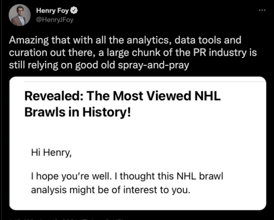In the fast-moving world of agency hustle, being present and focused amidst the buzz can be challenging. That is, we are always anticipating what’s next for our clients. Add in modern-day maladies —...
In the fast-moving world of agency hustle, being present and focused amidst the buzz can be challenging. That is, we are always anticipating what’s next for our clients. Add in modern-day maladies —...
Companies and brands turn to agencies for their deep knowledge of media outlets and a strong rolodex of reporter relationships. A key part of building those relationships is gaining reporters’ trust by demonstrating that we’ve done our homework and are reaching out with opportunities that are relevant to them. And that’s where a strong media list comes into play.
It’s tempting to pull a media list from a past announcement or download an online list of hundreds of contacts, but a “rinse and repeat” can lead to missed opportunities and a “spray and pray” approach can elicit adverse reporter sentiment - especially in today’s media environment. Why?
Reporters’ beats are evolving as trends take shape. Some examples include crypto and the future of work—two topics that were not in the mainstream when I started in PR over seven years ago. So you may be missing out on reporters who cover a hyper-specific beat that’s directly relevant. What’s more, reporters are chronically overwhelmed and have Twitter accounts, which means you’ll hear from reporters complaining about bad PR like this tweet from Henry Foy, a Financial Times European Diplomatic Correspondent...yikes! You don’t want to come across a Twitter post that’s obliquely referring to your pitch.

Here are a few considerations to keep in mind when creating a media list:
What is your news about?
In my mind, tech news disclosures generally fall under three broad categories and understanding where your news falls can give you a sense of how broad or how curated you should make your list.
What is your goal?
Think about what success looks like for you. Everyone hopes for that New York Times feature, but that is a rare occurrence and not specific enough.
Are you looking to associate your brand more closely with a certain trending conversation (thought leadership) or show that you’re ahead of competitors (product innovation/momentum) or convey a complex new service/product (product innovation/thought leadership).
This type of filter greatly informs who you’d be adding to your list. Depth versus. breadth can lead to completely different media lists. For depth pieces; you’re likely going the exclusive route and you’re offering something meaty to one outlet at a time. Looks can be deceiving and a long list may be significantly less impactful than a short, highly curated list.
Who are you targeting?
The goal for PR is for the right set of eyeballs to lock eyes with a placement that calls out a brand’s desired key messages. Are you reaching out to consumers? If yes, any specific demographic(s)? If you’re reaching out to SMB/enterprise, are you trying to get in front of sales leaders? HR? Developers? Trade media is where it’s at when it comes to reaching a business decision-maker but you have to ensure you’re zeroing in on the right type. HR leaders readers read HR Dive; sales leaders may read Forbes; developers may read ZDNet.
Who’s covering the topic in the last 6 months?
With reporters changing beats and positions so frequently, services like Cision, MuckRack, and OnePitch may not be up to date with the latest information on specific reporters and editors. Take advantage of their keyword search to pull up relevant influencers, but also apply that search to Google News, Bing News, Twitter and YouTube. You may come up with freelancers, podcasters, and non-traditional influencers who can either speak to your news really well or are speaking to your target audiences. No matter how much work you’ve put into your media list for past news, the research is never over! You always need to hit Refresh in your research to ensure that you’re not falling behind on new changes and trends.
Look beyond the bylines
Finally, in your actual research, note a reporter’s interests that they may share on Twitter or LinkedIn. It might be quite different from their day-to-day beat, but that doesn’t mean reporters can’t sometimes take assignments outside of their beat. And if they don’t, you at least have an advocate who can pass along your story to a colleague with a peer endorsement. Now more than ever reporters appreciate when their humanity is acknowledged, be it passion or stress.
6-April-2022
Alex Wilhelm of TechCrunch+ answered your questions about technology and journalism.
March-2022
In this BAM Book Jam, we sat down with Charmaine Wilkerson to talk about her novel, "Black Cake."
23-February-2022
We chatted with Alex Konrad of Forbes, Marlize van Romburgh of Crunchbase News, and Melia Russell of Insider.
LEAVE A COMMENT